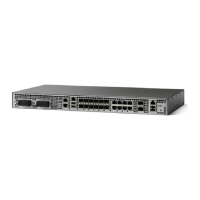Once a signal fail condition or a signal degrade condition is detected, the hardware initiates an interrupt to
software that switches from the working path to the protection path. Non-revertive options are valid for UPSR
path protection.
1X OC-192 and 8X OC-48 interface modules only supports the non-revertive option. The non-revertive
option is the default mode.
Note
When active link of UPSR and APS is configured on the same interface module and the interface module
reloads, the convergence number for UPSR circuits to switch to backup is high ranging from 100 ms to
200 ms. When each circuit is configured separately, the convergence time is always under 50 ms.
Note
The below table gives the maximum number of path level circuits supported in each mode.
Supported ScaleModes
84VT 1.5
48STS-1
16STS 3c
4STS 12c
1STS 48c
The following feature is supported on UPSR Path Protection:
•
SONET local connect and xconnect are supported at VT15 CEP, STS-1c, STS-3c, STS-12c, and STS-48c
levels. UPSR is also supported on TDM endpoints that are mapped to a pseudowire. T1 SAToP, T3
SAToP, and CT3 are not supported on an UPSR ring or in other words, local connect and xconnect of
T1, T3, and CT3 circuits to UPSR are not supported.
Configuring UPSR
Protection Group Configuration:
enable
configure terminal
protection-group 401 type STS48c
controller protection-group 401
type STS48c
cem-group 19001 cep
end
Configuring UPSR Work and Protection Path Configuration
UPSR Work Path Configuration:
enable
configure terminal
controller MediaType 0/3/6
mode sonet
controller sonet 0/3/6
rate oc48
sts-1 1 - 48 mode sts-48c
1-Port OC-192 or 8-Port Low Rate CEM Interface Module Configuration Guide, Cisco IOS XE Everest 16.7.x
(Cisco ASR 900 Series)
32
Configuring SONET
1+1 APS

